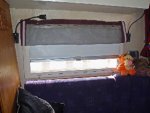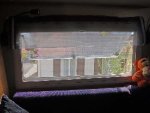mhiscox
Exp. Leader Emeritus
Here you go . . . Seitz Windows 101Since I have read a few other threads about who to get the Seitz windows from (Darrin at RUF) but one thing I have not been able to find any pictures of is how the shade/screen system works. . . . . Can you get me some pics of how they work and your opinions/thoughts on these? Things like how well do they keep out bugs, durability, etc.?
. . . in which I'll try to describe how these interesting windows work and why an overlander might or might not want to use them.
And, BTW, before someone has to point it out, there are a couple other manufacturers of this style of window in Europe, but Seitz is by far the market leader and thus gets to be, kinda like "Kleenex", the placeholder for the category.
It's worth noting that I'm only commenting on Seitz's awning window style, which is the more common form. Seitz does make slider windows, but the differences of the Seitz windows from typical RV windows are most obvious in awning form.
PROS:
- When you cut a hole of x square feet in your cabin, the window gives you x square feet of ventilation and an unobstructed view. A typical slider would be only open up half the area; a t-slider even less.
- Can be opened in rain.
- Double insulated, so no condensation and not cold to lean against.
- Screens are not blocking the view unless you're using them.
- Window shades exteriors are reflective.
- Generally cost less than double-insulated glass windows (though sometimes more than single panes).
- Available in many expo-cabin-friendly sizes.
- Lightweight things; might save as much as a couple hundred pounds over glass in a large cabin build.
- Not too tricky to install; screw the outer half to the inner half with lots of gooey sealant in between. (But see the "con" below about framing.)
CONS:
- The plastic scratches easily. And though they can be kept in good shape with polishing, I doubt anyone bothers.
- The flexible screen material ride in tracks on each side and the fit is bug-deterring rather than bug-proof. The screens work in most normal conditions, but they could not be trusted in epic bug situations. In such cases, you'll need to close the windows, which are bug proof, or, if you need the ventilation, use duct tape to seal the screen edges to the window frame. What's more, the screen mesh is probably too coarse for most no-see-um conditions, though nothing stops you from carrying cut pieces of fine mesh to layer onto the screen for these situations.
- The various mechanisms (rollers, hinges, latches) are engineered to work well enough with users who aren't too ham-fisted. But you couldn't characterize the windows as robust or overengineered. Of course, any failure you had would not be critical (and could be temporarily worked around with duct tape) and I personally have not had a problem in five-plus years of use. But the windows are 90% plastic, and fairly lightweight plastic at that.
- The edges of the screens and shades will come out the side tracks if you lean on them, though they go back in easily enough. And when the windows are open, you obviously have nothing to lean against, whereas a slider would have left half the window area solid.
- The gap between the outside and inside halves can't be reduced beyond about an inch. So installation is easy if you're putting them into a cabin sidewall panel, but if you want them in something like a sheet metal van wall, you have to build a frame of appropriate thickness around your opening. And while this isn't that tough, it looks a bit weird unless you then trim out the rest of the van interior to approximately the same depth. In point of fact, these windows probably aren't a good choice for thin-wall applications unless part of a complete interior finishing (as is the case in my Sprinter).
- You have to take care to get the right size. There are inside, outside, and nominal heights and widths on the order sheet and you need to be careful not to confuse measurements. The best advice is probably not to cut the holes until after the windows arrive.
- Everything about getting them is a pain in the butt. Dometic became the US distributor several years ago, which improved the situation somewhat; I had to get mine from Germany. But for a product you can get without a hassle from dozens of places (even on-line) in Europe, there are too many issues in North America. Most of the window sales are direct to manufacturers who are using the windows in RVs, so approaching your average Dometic-connected RV parts supplier will get a "no clue" response. But even when you find someone to order them, the delivery is slow and there is a history of sending the wrong sizes and having the windows, which were, and I believe still are, shipped in ordinary single-layer carbboard boxes, arrive broken. And, as Murphy would point out, if you're up against a deadline, they'll surely arrive broken or wrong; if you have lots of time, you're order will likely be fine. All kidding aside, it would not be a mistake to start to get the windows four or more months before you wanted to install them.
-----
So, how do they work? Here's a picture of the exterior half of an average-sized window:

The bottom is to the left in the picture. The window "glass" is acrylic plastic sealed all around the edges but with most of the area being a double-layer section with an airspace in-between. Thus the edges are pretty thin, about a quarter inch, while the middle is closer to an inch thick. Interestingly, from the interior, the window pooches outwards so that there's about two inches between the interior edge of the frame and the surface of the glass. This actually worked to great advatage in my Sprinter, making the width between the window glass about four inches wider than the van interior, which created more length for sleeping on my crosswise bed.
Notice the single latch at the bottom (wide windows have two bottom latches) and the harder-to-see latches on each side a little ways up from the bottom. Each latch rotates a quarter turn to let the "glass" raise up; you can see the metal top hinge, into which the top edge of the glass slides, on the right of the picture. The two metal things on the sides are the "hold-it-up" mechanisms. They click into place at three places along the rod, allowing the window to stay open at, more or less, one-third, two-thirds and fully opened, fully opened being perpendicular to the closed position. Once you've gone to or beyond the first position, you close the window by raising it past fully opened position (to about 110 degrees), which releases the rod and lets the window close. There's no pressure-assist, and no way to open the windows to anything except the fixed positions, unless you choose to carry a set of custom-length prop rods.
Below is the interior view of the interior half. Sadly, my photo model held the window upside down in the picture; the holes in real life are at the bottom.

The shade part is on a spring-loaded roller. The shade is normally retracted into the bottom edge of the cassette (as they call it) and held by the spring. The edges of the shade run in tracks on the sides of the cassette. The top-edge of the shade has squeeze-type latches on each edge. To raise the shade, squeeze the latches, pull up against the roller's spring pressure and, when the shade is raised to the amount you want, stop squeezing. The shade latches will click into a groove about where you let it go. The shade will not hold ajust anywhere, but there are grooves about every two inches, so there's decent adjustability.
The screening is the reciprocal of the shade. It's on a spring-loaded roller in the top of the cassette, also with edges that run in the tracks. The screening is a mesh fabric. It only gets tensioned by being on the spring roller at the top and being latched at the bottom. The screen latches into position by attaching to the top edge of the shade. The screen will not stay extended unless it is latched to the top of the shade, which is, in turn, held into the side grooves by the squeeze latches. Connecting the bottom of the screen to the top of the shade is done with one or two (on wide windows) latches, and the shade-top/screen-bottom connection is made tight because there's an interlocking groove arrangement between the screen and shade metal edges.
The picture shows the interconnection and from it, perhaps you can get the idea of how
(percent covered by shade) + (percent covered by screen) = 100%.
If you want more screen, you get less shade and vice versa. This might be initially be considered a negative, since you essentially don't get ventilation when the shades are fully drawn. In practice, you often have the shades drawn when it's dark, and when it's dark, it's often cooler and the ventilation doesn't matter. More to the point, though, this isn't any worse than any other setup; put a roller shade across a typical RV slider window and you won't do any better.The shade material is quite opaque, but some light will leak around the side edges and so the shades won't work to get the cabin pitch dark. To the good, though, the exterior side of the shades is reflective and undoubtedly does some good at keeping things slightly cooler.
-------
As a personal summary . . . I was very pleased with the Roxio plastic awning windows in my Unimog camper, and I'm very happy that experience led to the decision to put the similar Seitz windows in my Sprinter. In my situation, the advantages considerably outweigh the disadvantages. By far the two biggest benefits are the lack of condensation and cold spots and the amount of unobstructed light and view available. In fact, I have a hard time getting excited about most of the current Class B Sprinter conversions because of their inferior window setups.
But the Seitz windows are not for everyone, and the hassle of getting them demands more effort and patience than it should. Still, for most expedition cabin builders, they deserve a lot of consideration.
If there are any questions prompted by this lecture, please post them here and I'll try to answer them.
Last edited:







